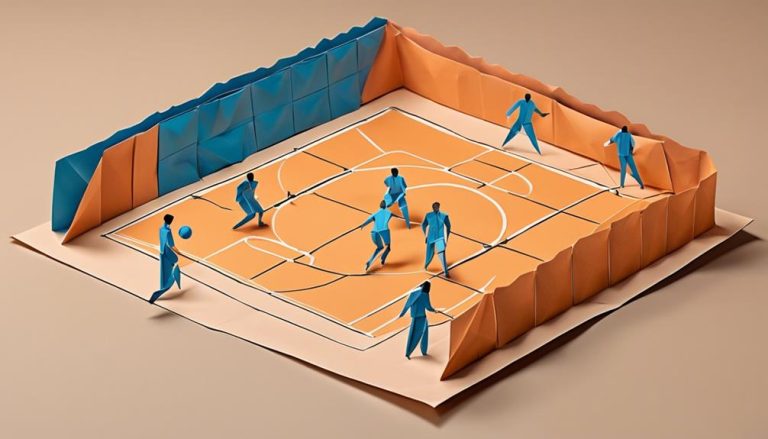General Rules of Track Cycling
When it comes to track cycling, mastering the rules is like knowing the twists and turns of a challenging course. Understanding the nuances of track cycling can be the difference between a successful race and a disappointing outcome. From the specific equipment required to the strategic maneuvers employed during a race, each aspect plays a crucial role in determining the winner. As you navigate through the various elements of track cycling, you'll uncover the key principles that can elevate your performance to new heights.
Track Cycling Equipment
When gearing up for track cycling, ensure you have the right equipment to maximize your performance on the velodrome. Gear selection plays a crucial role in your success on the track. Choosing the right gear ratio is essential, as it affects your speed and cadence. Opt for a gear ratio that suits your riding style and the track's characteristics. Additionally, make sure your bike is equipped with quality components that are not only lightweight but also durable.
Bike maintenance is another key aspect to consider. Regularly inspect your bike for any wear and tear, and ensure that all components are properly adjusted. Keep your chain clean and well-lubricated to prevent any issues during your ride. Proper tire inflation is crucial for optimal performance, so check your tire pressure before hitting the track. Lastly, don't forget about your braking system. Make sure your brakes are in top condition to ensure your safety and control on the velodrome. With the right gear selection and diligent bike maintenance, you'll be ready to conquer the track with confidence.
Velodrome Rules and Etiquette
Ensure you familiarize yourself with the velodrome rules and etiquette to navigate the track smoothly and safely. Velodrome etiquette is essential for a seamless and enjoyable track cycling experience. Here are some key points to keep in mind:
| Velodrome Rules | Velodrome Etiquette |
|---|---|
| Always ride in the same direction as the track. | Respect other riders' space and avoid sudden movements. |
| Use hand signals to communicate with other cyclists. | Yield to faster riders when necessary. |
| Follow the designated passing lanes when overtaking. | Do not abruptly stop or change lanes without checking your surroundings. |
When it comes to track racing strategies, understanding and adhering to velodrome rules and etiquette can give you an edge. By maintaining proper decorum on the track, you not only ensure your safety but also contribute to a harmonious cycling environment. Embrace these guidelines as you hone your skills and tactics for successful track racing.
Sprinting and Endurance Strategies
To excel in track cycling, mastering sprinting and endurance strategies is pivotal for achieving optimal performance on the velodrome. When it comes to sprinting tactics, it's essential to conserve energy in the initial laps, staying behind the lead rider to draft and reduce wind resistance. As you approach the final stretch, unleash your maximum power, utilizing explosive speed to surge ahead and cross the finish line first. Pacing strategies play a crucial role in endurance races, such as the pursuit or points race. Maintaining a steady pace throughout the event is key to preserving energy for strong finishes and strategic moves. By understanding when to push hard and when to conserve energy, you can outmaneuver your opponents and secure victory. Remember, mastering sprinting tactics and pacing strategies will give you a competitive edge on the velodrome, helping you achieve success in track cycling events.
Overtaking and Positioning Tactics
Maximizing your speed and strategic positioning are essential elements in mastering overtaking tactics during track cycling races. When it comes to overtaking techniques, understanding the following strategies can give you an edge on the velodrome:
- Drafting: Utilize the slipstream behind another rider to conserve energy and make a swift pass when the time is right.
- Timing: Knowing when to make your move is crucial. Anticipate your opponent's actions and be prepared to accelerate at the opportune moment.
- Body Position: Adjust your body to reduce wind resistance and increase speed when overtaking. Every aerodynamic advantage counts.
- Cornering: Position yourself on the inside of turns to maintain a shorter distance and potentially overtake your rivals on the bend.
- Psychological Warfare: Use strategic positioning to intimidate your opponents, forcing them to make mistakes and opening up opportunities for overtaking.
Race Start Procedures
When lining up for a track cycling race, understanding the intricacies of the race start procedures is crucial for a successful start and positioning yourself for a strong performance. To prepare effectively, begin with a thorough pre-race warm-up routine. This helps loosen your muscles, increases blood flow, and primes your body for the intense effort ahead.
Race Start Procedures Table:
| Starting Positions | Description | Tips |
|---|---|---|
| Pole Position | Front row, innermost lane | Maintain control, accelerate quickly |
| Middle Position | Front row, middle lane | Stay alert for moves from both sides |
| Outer Position | Front row, outer lane | Use the banking to your advantage, plan overtakes |
Ensuring you secure the best starting position possible is essential. Pole position offers a clear advantage, while the middle position requires heightened awareness. The outer position can be strategic if used wisely. Remember, your start can significantly impact your race, so practice different starting scenarios to be prepared for any situation.
Penalties and Disqualification
Let's talk about the points system in track cycling. Points are crucial in understanding how penalties and disqualifications can impact a racer's standing in a competition. By grasping the penalty types and disqualification protocol, you'll navigate the rules with confidence and ensure fair play during races.
Penalty Types Explained
Exploring the various penalty types in track cycling provides a deeper understanding of the consequences athletes face for rule violations. In the world of track cycling, penalty enforcement is a crucial aspect to ensure fair play and safety on the track. Here are five types of penalties you might encounter:
- Warning: A verbal caution for a minor rule infraction.
- Fine: A monetary penalty for more serious violations.
- Time Penalty: Additional time added to an athlete's final race time.
- Disqualification: Removal from a race due to a severe rule violation.
- Suspension: Temporary exclusion from future competitions for serious misconduct.
Understanding these penalty types can help you navigate the rules of track cycling and compete with integrity.
Disqualification Protocol Overview
In track cycling, understanding the disqualification protocol is crucial for athletes aiming to compete at their best and abide by the rules of the sport. The disqualification process is implemented when a rider violates specific rules, such as dangerous riding, hindering opponents, or leaving their designated racing line. Consequences for breaching these regulations can range from warnings to removal from the race, depending on the severity of the infraction. It's important to grasp the disqualification protocol to avoid penalties that could hinder your performance or result in disqualification. By being aware of the rules and consequences, you can ensure fair competition and uphold the integrity of track cycling events. Stay informed and race with respect for yourself and your fellow competitors.
Frequently Asked Questions
How Can Track Cyclists Prevent Injuries While Training and Competing?
To keep injuries at bay, remember to stretch like a graceful cat before roaring into intense training. Taper wisely, like a marathoner nearing the finish line, to let your body recover and shine.
Are There Any Specific Nutrition Recommendations for Track Cyclists to Optimize Performance?
To optimize performance, track cyclists should focus on tailored nutrition strategies. Hydration tips play a crucial role in maintaining peak performance. Consistent fueling with complex carbs and lean proteins fuels your rides effectively. Stay hydrated and energized!
What Are Some Common Mistakes That Beginner Track Cyclists Should Avoid?
Imagine a dance; you glide across the track, the rhythm of your pedals in sync with your heart. To avoid mishaps, ensure proper gear selection and form. Embrace the journey, learn, grow.
How Can Track Cyclists Improve Their Mental Focus and Concentration During Races?
To boost your mental game in races, try visualization techniques and breathing exercises for focus. Embrace positive self-talk and mindfulness to stay sharp. Remember, mental strength is key for success on the track!
Are There Any Specific Recovery Techniques That Track Cyclists Should Incorporate Into Their Training Regimen?
You gotta treat your body like a temple, buddy! Recovery methods are your secret weapon for performance enhancement. Think ice baths, foam rolling, and proper nutrition. Treat yourself right to dominate on the track.






